FOLLOW US ON TWITTER @SaveOurBucks
In the wake of the Milwaukee Bucks’ sale announcement, a few critics of either the Bucks or a new arena decided to quickly get vocal about things. As a result, a number of urban myths were started to advance the narrative that the community doesn’t need to build a new arena nor bother to retain the team in Milwaukee, as it has no positive economic impact.
Here were some of the “truths” advanced last week in certain quarters around town:
“The ‘buyback clause’ in the franchise sale agreement is a bad faith attempt by the NBA to coerce Milwaukee into a new arena and/or take away our team”
“It is completely unfair that the NBA can tell Milwaukee to build a new arena in order to keep the team in Milwaukee long-term”
“We just heard that the Golden State Warriors are going to build their own privately-financed arena! This is a GAME-CHANGER and the Bucks should pay for all of it!”
“The Bucks have no economic impact. If they left, people would just spend their ticket money on movies, restaurants or other activities”
We’ll debunk all these myths and more! Read on!
Myth #1 -The “buyback clause” in the franchise sale agreement is a bad faith attempt by the NBA to coerce Milwaukee into a new arena and/or take away our team.
This one caused a great deal of excitement on the talk shows and local news. The implication was that this provision was designed to either exploit the Milwaukee market into building a new arena or was some sort of nefarious provision inserted into the deal by Lasry and Edens to allow them to move the team in a year or two. Steve von Horn over at Brewhoop does a nice job explaining what this clause does and how it protects the fans of Milwaukee and provides incentives to all parties to get a new arena built sometime in the next 3-5 years.
 The NBA has for years told Milwaukee that we need a new arena or we will not have an NBA team here long term. People who have not been following the Bucks closely apparently were not aware of this situation. NBA Commissioner Adam Silver has talked about this repeatedly in the past year, well before Senator Kohl ever put the team on the market last December.
The NBA has for years told Milwaukee that we need a new arena or we will not have an NBA team here long term. People who have not been following the Bucks closely apparently were not aware of this situation. NBA Commissioner Adam Silver has talked about this repeatedly in the past year, well before Senator Kohl ever put the team on the market last December.
The buyback clause was put into the deal specifically to PROTECT Milwaukee from having the new owners make a half-hearted attempt at a new arena and then move the team or flip the franchise to buyers from Seattle or another market. The League and Senator Kohl wanted to make sure the Bucks avoided the Sonics debacle that took place when the Seattle franchise was sold, and their new owner Clay Bennett made a half-hearted attempt to stay before quickly moving the team to Oklahoma City. In contrast, Lasry and Edens now have every incentive to make an arena deal work in Milwaukee — or risk having to sell the team back to the league for a much smaller return.
Certain people around Milwaukee were not familiar with any of these issues, and evidently just assumed that once the Bucks were sold to new owners, the concept of a new arena was “optional” and that the team could remain in the Milwaukee forever, playing in an aging Bradley Center. This was never the case.
Myth #2 – It is completely unfair that the NBA can tell Milwaukee to build a new arena in order to keep the team in the Milwaukee long-term
Stemming off the first myth, a number of people this past week asked “How can the league require the Bucks to have a new arena?” This is very simple. As a small market team, the Bucks are “Takers” under the league’s collective bargaining agreement. Because Wisconsin and Milwaukee are small markets compared to many others around the country such as New York, Los Angeles, Dallas, Houston, etc (Milwaukee ranks 33rd in Metropolitan Statistical Area Population) the League wants to ensure that all small markets are doing their part to maximize revenues. The Bucks right now play in a facility that doesn’t accomplish that.
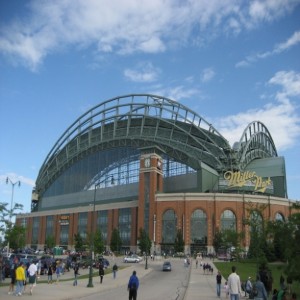 Newer arena facilities are approximately 30-40% larger than the current Bradley Center in size. They provide restaurants, shops, and fan experience attractions that all generate revenues for the team. If you need a better visualization of this, remember what your fan experience was like at County Stadium and then compare it to Miller Park. Miller Park has interactive areas for families, the 300 Club (now the Johnson Controls Stadium Club), TGI Fridays Restaurant, lounges and numerous other fan amenities. In contrast, old County Stadium had tiny plastic seats and the “Fan-o-Gram.” A framed Hank Aaron Jersey hanging on the wall at the main entrance comprised the bulk of the non-game attractions. Big excitement at County Stadium occurred if you were lucky enough to have premier “mezzanine” seats and could traverse the narrow catwalk in mid-air over the lower grandstand to get to your metal folding chairs located in that section. We don’t miss it.
Newer arena facilities are approximately 30-40% larger than the current Bradley Center in size. They provide restaurants, shops, and fan experience attractions that all generate revenues for the team. If you need a better visualization of this, remember what your fan experience was like at County Stadium and then compare it to Miller Park. Miller Park has interactive areas for families, the 300 Club (now the Johnson Controls Stadium Club), TGI Fridays Restaurant, lounges and numerous other fan amenities. In contrast, old County Stadium had tiny plastic seats and the “Fan-o-Gram.” A framed Hank Aaron Jersey hanging on the wall at the main entrance comprised the bulk of the non-game attractions. Big excitement at County Stadium occurred if you were lucky enough to have premier “mezzanine” seats and could traverse the narrow catwalk in mid-air over the lower grandstand to get to your metal folding chairs located in that section. We don’t miss it.
Recently built arenas are designed to provide a much better fan experience for not only the people sitting court side but also the people in the upper deck. The Bradley Center was built primarily for hockey, and the site-lines for basketball are very poor. For any of you who have sat in the upper deck of the Bradley Center, you know what we are talking about. You first have to climb Mount Everest to get to your seat. Then once there, you have a prime view of the arena catwalk and banners hanging down from the ceiling rather than being able to easily see the court. Just as problematic is the relative distribution of seats between the upper and lower bowl. The BC’s lower bowl of approximately 8,000 seats is dwarfed by most modern arenas, many of which boast multiple levels of lower, club and loge seating in order to bring fans closer to the game.
When you provide a better fan experience, the club can then generate more revenue just as the Brewers now do with Miller Park or the Packers with the rebuilt Lambeau Field. So that brings us back to the question of why the NBA can require the Bucks to play in one of these newer facilities.
The answer is simple, the Bucks other business partners in the league are sending into the State of Wisconsin tens of millions of dollars of outside revenue generated by the league in order to subsidize the Bucks. The league’s national TV contract generates approximately $33 million a year for every team and that number is expected to possibly double when said TV contract is renewed in 2016. Further, the 2011 collective bargaining agreement’s revised revenue sharing system provides significantly more money to small market teams like the Bucks, providing up to $16 million per year in revenue sharing dollars. These league revenues coming into Milwaukee don’t include all the other league revenues the team receives from their share of global merchandising (we hear they sell a lot of Kobe Bryant jerseys overseas), broadband rights and international operations such as NBA China.
Opponents of a new arena might read the paragraph above and think to themselves – “See, I told you the Bucks can’t make it here! They need all sorts of subsidies from the league to operate. Just let them leave!”
Well guess what: The Brewers and the Packers also need many of those same league subsidies to operate in Wisconsin as well. If former NFL Commissioner, Pete Rozelle, hadn’t required the NFL to equally divide TV revenues among all clubs, the Packers would have left Wisconsin decades ago, due to our small media market. Because TV revenue was so important, revenue sharing allowed a small-market team like the Green Bay Packers to compete for the same talent as the big market New York Giants.
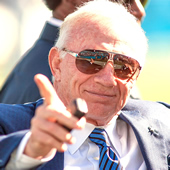 In exchange for this sharing of revenues, large market NFL owners expect the smaller markets to maximize their revenues in other ways in order to reduce the subsidy the league needs to distribute. Many years ago, Cowboys owner Jerry Jones went out after the Packers (and other teams) for not working hard enough to maximize local revenues. Jones didn’t like the fact that his Cowboys were generating so much revenue that had to be shared with other teams. As a result of this, the Packers embarked on the major renovations to Lambeau Field and new marketing ventures, to allow the team to generate this additional local revenue to help them compete, and to quiet any criticisms from large market owners.
In exchange for this sharing of revenues, large market NFL owners expect the smaller markets to maximize their revenues in other ways in order to reduce the subsidy the league needs to distribute. Many years ago, Cowboys owner Jerry Jones went out after the Packers (and other teams) for not working hard enough to maximize local revenues. Jones didn’t like the fact that his Cowboys were generating so much revenue that had to be shared with other teams. As a result of this, the Packers embarked on the major renovations to Lambeau Field and new marketing ventures, to allow the team to generate this additional local revenue to help them compete, and to quiet any criticisms from large market owners.
The Brewers are in the same situation. They too rely on shared revenues from the larger market teams in order to carry a team payroll that has a chance of being competitive. But as we’ve learned with the Brewers this past decade, you still need those enhanced local revenues that Miller Park provides, in order to have a payroll in the $60-$100 million dollar range. As Mark Attanasio has said, strong Miller Park revenues mean the Brewers can add players this year. Weak revenues mean a lower payroll. County Stadium was never going to be able to generate those local revenues the Brewers needed, nor can the Bradley Center generate those revenues for the Bucks.
The NBA operates the same way as the NFL and MLB. They’ve made a deal with the small market owners: we will revenue share with you, but you’ve got to pull your own weight as best you can. And if you aren’t doing your part with a modern stadium or arena that maximizes your local revenue, we aren’t going to be happy sending you in perpetuity a 1/30th share of all our league revenue generated world-wide.
As long as there are numerous other markets that want an NBA team, it isn’t all that unfair for the league to make this request. By the way, it isn’t just Seattle that wants an NBA team. Las Vegas, Louisville and Kansas City are all awaiting their opportunity should Milwaukee fumble this. The Kansas City and Louisville arenas are already built. The new Las Vegas arena breaks ground on May 1st.
Myth #3 – We just heard that the Golden State Warriors are going to build their own privately financed arena! This is a GAME-CHANGER and the Bucks should pay for all of it!
Let’s continue the discussion from above regarding large markets and small markets. As we noted, Milwaukee is ranked as the 33rd largest metro area by population. San Francisco, where the Warriors new arena is proposed, is the 5th largest metro area. The San Francisco MSA has an estimated population of 8.3 million people, with the nation’s highest median household income ($63,024). The Milwaukee MSA has an estimated population of 2.0 million. while ranking 37th in median household income ($46,132).
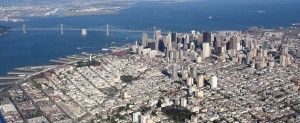 Indulge us for a moment as we contemplate the differences in size and wealth between the two markets. It might just be that owners of any civic arena in the San Francisco Bay area could make a lot more money running such a venue there, than in Milwaukee, even if they didn’t have an NBA team as anchor tenant.
Indulge us for a moment as we contemplate the differences in size and wealth between the two markets. It might just be that owners of any civic arena in the San Francisco Bay area could make a lot more money running such a venue there, than in Milwaukee, even if they didn’t have an NBA team as anchor tenant.
There are FOUR times as many people able to attend revenue generating events at a Bay Area arena as are available here. Further, top acts such as the Rolling Stones by definition play multiple night engagements in cities such as San Francisco versus Milwaukee, where we are lucky to have the Stones play here once every decade. Of course it is going to be more feasible to privately build and profitably run such a venue in a massive market like the San Francisco Bay area. And it’s no coincidence that Sacramento — just 85 miles away but 25th in MSA terms — is relying on an estimated $255 million in public funding to build the Kings’ proposed new arena. The San Francisco arena situation is a straw-man, with few commonalties to the arena situation in Milwaukee, save for NBA teams being anchor tenants.
Because our market is smaller and much less lucrative for developers than San Francisco, partial public financing may be required. Should we self-limit our opportunity to have many of the cultural activities such as the Bucks, concerts, conventions and other civic events because we do not want to contribute anything towards the cost of competitive facility? The region is going to have to support repairs and maintenance on the Bradley Center to the tune of an estimated $100 million over the next ten-years if it is not replaced. Can the Bradley Center even survive without the Bucks as the anchor tenant? Public assistance for some form of arena facility in Milwaukee is going to be a reality, with or without the Bucks.
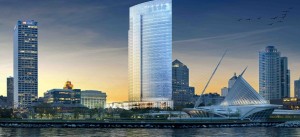 Would we all prefer that public money not be requested or required in situations like new arena projects? Of course, just as in an ideal world, Northwestern Mutual Life Insurance Company would not have required a $73 million dollar TIF district to locate their new office tower in downtown Milwaukee. Unfortunately though, this is how the game is played in virtually every city and state in the country. We have a free market in terms of where companies and sports franchises can locate, and in cities like New York, LA and San Francisco, many times they do not need to offer significant public financing because those markets are so lucrative on their face that teams won’t ever leave them.
Would we all prefer that public money not be requested or required in situations like new arena projects? Of course, just as in an ideal world, Northwestern Mutual Life Insurance Company would not have required a $73 million dollar TIF district to locate their new office tower in downtown Milwaukee. Unfortunately though, this is how the game is played in virtually every city and state in the country. We have a free market in terms of where companies and sports franchises can locate, and in cities like New York, LA and San Francisco, many times they do not need to offer significant public financing because those markets are so lucrative on their face that teams won’t ever leave them.
Myth #4 – The Bucks have no economic impact. If they left, people would just spend their ticket money on movies, restaurants or other activities.
We heard this one thrown around quite a bit as well. People making this argument do not understand the economic impact of the Bucks situation in particular, and how much revenue they bring into the State of Wisconsin due to their small market status.
The community has talked a lot the last ten years about businesses leaving the State for greener pastures. Wisconsin needs jobs, we need businesses, we need employers here. The Bucks are a big business that is headquartered here and one that brings in a great deal of outside revenue.
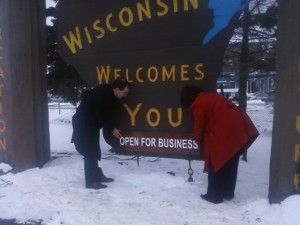
Governor Walker installs “Open For Business” Sign
We’d like arena opponents to ask themselves these questions:
– What local businesses, if put on the market, would sell for $650 million? (The purchase price plus arena contribution)? We’d venture the list is small.
– What Wisconsin companies have been sold to out-of-state interests the past two decades, but said out-of-state interests were required to keep the business headquarters, employees and all operations here locally, as will be the case with the Bucks?
– What Wisconsin businesses derive over half of their revenue from out-of-State customers as the Bucks do with their annual league sourced revenues mentioned above, that flow into Wisconsin to be taxed and spent here?
– What Wisconsin businesses have the name “Milwaukee” in their title and are recognized by 300-500 million people in China? Ask any State business owner engaged in commerce in China about former Bucks player Yi Jianlian. He never became a star or household name in Milwaukee, but huge numbers of people in China knew of Milwaukee because of him.
– What Wisconsin businesses are providing $250 million dollars ($100mm Kohl, $100mm new owners, $50mm naming rights) for a major new construction project in downtown Milwaukee, to build a unique facility that can be used by the community for 150-200 nights per year? A facility that will likely be built by a local company (Hammes), will employ a few thousand construction workers and have a construction multiplier effect on the local economy?
– What business will replace the $60+ million in annual taxable income created by NBA players competing in Milwaukee at least 41 nights per year? Player salaries annually account for $4+ million in potential income tax revenue that would not be replaced should the Bucks leave Milwaukee, and it’s a number that figures to grow by well over the rate of GDP over the coming decade. And that tax revenue doesn’t include income taxes, property taxes and sales taxes paid by all the other front office employees of the team and people working at a new arena.
Last year Forbes estimated the Bucks revenues at approximately $109 million. Of that, only $21 million was from local ticket revenue. Sure, if the Bucks leave, that $21 million in ticket revenue gets spent elsewhere, maybe at movies and bars. But much of the other revenue, now coming from national and global league sources, will leave Wisconsin for good. That out of State money right now is used to fund payrolls, jobs and taxes here in the State of Wisconsin.
If people want to let a business of this magnitude walk, they have a right to that opinion, but frankly we can’t understand that sentiment. If the Bucks leave, what new business is the State of Wisconsin guaranteed to attract that has the economic strengths listed above? We can’t think of any.
Future Details Will Shape the Discussion
Keeping the Bucks here may require some level of public investment in a new facility. We understand people’s reluctance to provide any type of public funding for arena projects. However, State and local governments nationally enter into such public-private partnerships on a daily basis in an effort to maintain and grow local economies. When this debate was foreshadowed at various points the past decade, who would have thought we’d have $200 million in private money committed at the outset of the discussion? Add-in an estimated $50 million dollars in potential naming rights, and we’ve already got a private contribution to the arena investment that exceeds most public-private partnerships done here or nationally. And additional private money may be part of the final plan.
All we’d ask of the new arena critics is that they take the time to better understand the economic structure of this particular team, its impact on the local economy and the impact a new arena will have on the region as the community begins this dialogue. We have no idea how much a new facility will cost, what it will look like, where it might be located and what dollar amount might ultimately be asked of from the public to complete such a project.
If you still want to oppose any public funding after all the facts are on the table, that’s OK. That is your choice as a citizen and voter. However, this week we’ve heard far too much uninformed noise in the community by certain special interests, spreading the myths above in order to achieve their own political gains.
 The amazing thing about this debate is that while we await further details, we’ve already got a local example of a home-run project of this nature. Even the most emphatic detractors of the Miller Park project will admit that in hindsight, the new stadium has been a huge success. The new park allows the Brewers to be more competitive on the field, while providing a pleasurable and unique experience for fans. Millions have gone through those gates to enjoy an afternoon or evening with friends and family. Were there some mistakes made in certain aspects in structuring the Miller Park transaction? Certainly, but we can learn from those minor mistakes in formulating the plan for a new arena. More importantly, we are starting out with over $200 million in private funding from the Bucks, compared to Miller Park, that ended up with zero dollars contributed by the Brewers, other than the $40 million for naming rights from Miller Brewing Company.
The amazing thing about this debate is that while we await further details, we’ve already got a local example of a home-run project of this nature. Even the most emphatic detractors of the Miller Park project will admit that in hindsight, the new stadium has been a huge success. The new park allows the Brewers to be more competitive on the field, while providing a pleasurable and unique experience for fans. Millions have gone through those gates to enjoy an afternoon or evening with friends and family. Were there some mistakes made in certain aspects in structuring the Miller Park transaction? Certainly, but we can learn from those minor mistakes in formulating the plan for a new arena. More importantly, we are starting out with over $200 million in private funding from the Bucks, compared to Miller Park, that ended up with zero dollars contributed by the Brewers, other than the $40 million for naming rights from Miller Brewing Company.
And if your only objection to a new arena is that “The Bucks stink – The Brewers are good,” we want to remind you that Miller Park was approved in 1995, during a time when the Brewers were in the midst of a long string of losing seasons, while few attended their games at County Stadium. With new ownership and a new stadium, the fortunes of the Brewers turned around quickly. We anticipate the same for our local basketball team. Go Bucks!

Great response. Thank you for your tireless efforts. This fan appreciates all of it.
Great article, but the China commentary is off the mark.
We’ve not been to China, but at the same time, we think there is something there to the global value of the Bucks. Check out this Milwaukee Business Journal story by Rich Kirchen from yesterday regarding the NBA and NBA China.
http://www.bizjournals.com/milwaukee/blog/2014/04/international-value-assumption-of-debt-drove-bucks.html